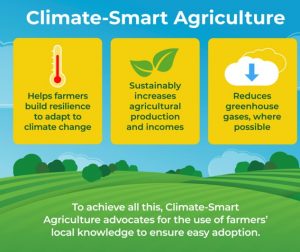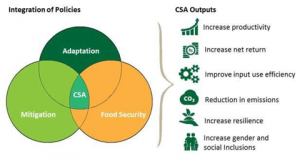ForumIAS announcing GS Foundation Program for UPSC CSE 2025-26 from 27th May. Click Here for more information.
Source: The post Climate-smart agriculture (CSA) has been created on the article “Need for climate-smart agriculture in India” published in “The Hindu” on 25th November 2023.
UPSC Syllabus Topic: GS paper 3– Environment – climate change
News: The article discusses climate-smart agriculture (CSA) as a way to address climate change and improve farming. CSA helps increase farm productivity, adapt to climate changes, and reduce greenhouse gases. It’s important for sustainable development, food security, and meeting global climate goals.
What is Climate-Smart Agriculture (CSA)?
According to the Food and Agriculture Organization (FAO), CSA is an approach designed to transform and reorient agricultural systems to support sustainable development and secure food security in the face of climate change.
It focuses on 1) increasing agricultural productivity and incomes, 2) adapting and building resilience to climate change, and 3) reducing or removing greenhouse gases.
CSA includes various practices like water-smart (efficient water use), weather-smart (responding to weather changes), energy-smart (using energy efficiently), and carbon-smart (reducing carbon footprint) methods.

What are the benefits of CSA?
Increased Agricultural Productivity: CSA sustainably boosts farm productivity; crucial as global food demand is projected to increase by 60% by 2050.
Enhanced Adaptation to Climate Change: CSA promotes crop diversification and integrates drought-resistant crops, increasing water efficiency.
Greenhouse Gas Reduction: CSA plays a crucial role in reducing greenhouse gases, which is vital considering agriculture contributed 17% to global emissions in 2018.
Sustainable Food Security: CSA contributes to long-term food security, which is essential in a world with a growing population and changing diets.
Environmental Protection: CSA ecosystem-based approach helps in coexisting croplands with wild areas, protecting native species and pollinators.
Flexibility and Broad Application: CSA is not a rigid set of rules but a flexible approach with a wide range of applications. This adaptability allows it to be effectively implemented in various agricultural contexts and regions.
Socio-Economic Transformation: CSA provides access to climate-resilient methods and information, greatly benefiting farmers, especially those in disadvantaged positions.

What are the challenges of CSA?
Novelty and Limited Scope: CSA is relatively new, particularly in countries like India. For example, the scope of initiatives like precision farming is still limited.
Localizing Responses: Each region has unique climatic and agricultural conditions that require tailored approaches.
Balancing Economic and Environmental Goals: Balancing the economic needs of farmers with environmental sustainability is complex and requires careful planning and support.
For more information on challenges of CSA read here
What initiatives have been taken to implement CSA?
Global Initiatives for CSA
Sustainable Development Goals: CSA aligns with the United Nations’ Sustainable Development Goals, particularly in ending hunger and enhancing environmental management through sustainable agriculture.
Paris Agreement: CSA practices like agroforestry and carbon sequestration support the Paris Agreement’s objective to reduce greenhouse gas emissions.
Initiatives in India
National Action Plan on Climate Change: Emphasizes the role of climate-resilient agriculture in India’s adaptation strategies.
Government Programs: Includes National Adaptation Fund for Climate Change, National Innovation on Climate Resilient Agriculture, and Soil Health Mission, focusing on sustainable farming practices.
Private Sector Involvement: Private companies and farmer-producer organizations are actively working towards CSA adoption in India.
For more information on Indian government initiatives read here
What should be done?
- Increase efforts to educate farmers about CSA practices, especially in areas like India where these methods are still emerging.
- Strengthen capacity-building programs to support the widespread adoption of CSA, including training and resource allocation.
- Strengthen the collaboration between government initiatives and private sector efforts to ensure a cohesive approach towards CSA adoption and practice.
Question for practice:
Discuss how Climate-Smart Agriculture (CSA) contributes to sustainable development and food security while addressing the challenges posed by climate change.



